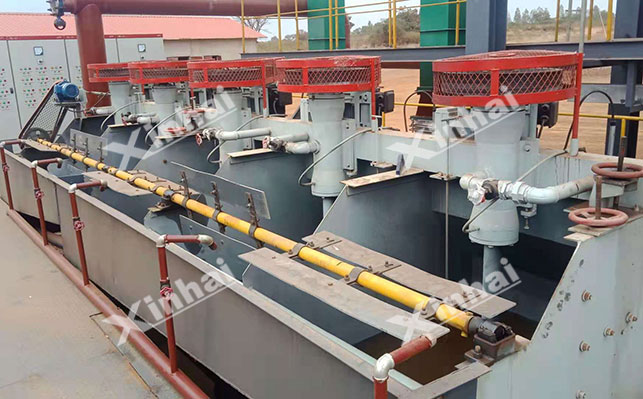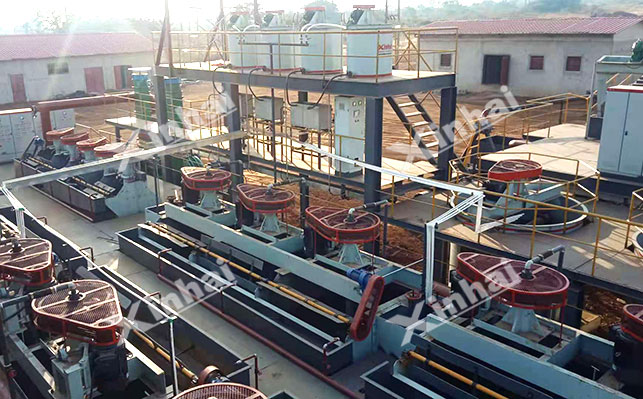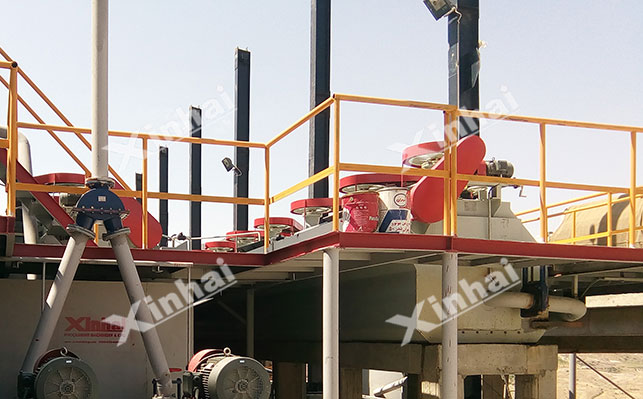
15311826613
Click to add WeChatRecently, the price of gold has fallen sharply, but it has no impact on gold mine development. As easily exploitable rich ore resources gradually decrease, poor ores, fine-grained embedded ores, and complex multi-metallic paragenesis ores have become the main development force. For this type of gold mine, flotation gold extraction is often used to achieve recovery.
At present, about 40%-50% of the world's gold production is contributed by flotation. This technology originated in the early 20th century. With the progress of materials science and pharmaceutical research and development, it has developed from a traditional single flotation process to a variety of combined processes. It is widely used in various types of gold mines, especially fine-grained embedded, multi-metallic paragenesis and other difficult-to-treat gold mines, and has become one of the core technologies of modern gold beneficiation.
So how to use flotation to extract gold? What are the methods of flotation to extract gold? What are the advantages? This article will answer and introduce these two questions.

The process of flotation gold extraction follows the principles of thermodynamics, and its essence is to reduce the free energy of the gas-liquid-solid three-phase interface. When the surface of gold minerals contacts and adheres to bubbles, the total surface energy of the system decreases, and the process proceeds spontaneously. The wettability of the gold mineral surface is a key factor. Hydrophobic gold minerals are easy to combine with bubbles, while hydrophilic gangue minerals are difficult to adhere. By adding reagents, the surface properties of the minerals can be changed to achieve the separation of gold and gangue. The floatability of gold varies depending on its occurrence state:
Floatability of natural gold: Its surface has a certain hydrophobicity, but it is easily affected by oxidation, impurity encapsulation, etc. When the surface of natural gold is pure, it can be floated directly; if the surface is oxidized or covered by clay, it needs to be treated with grinding and adjusting agents to restore its hydrophobicity.
Floatation of associated sulfide ores: Pyrite, arsenopyrite and other associated sulfide minerals often coexist with gold, and their floatability is similar to that of gold. During flotation, the selectivity of the collector should be used to preferentially or simultaneously recover sulfide minerals and indirectly enrich gold.
Symbiosis of gold and carrier minerals: Gold often exists in carrier minerals such as quartz and sulfide in the form of fine particles or symbiosis. Flotation requires grinding to fully dissociate gold, and at the same time, the reagent is selected according to the properties of the carrier mineral. For example, when treating gold-bearing pyrite, inhibitors can be used to inhibit pyrite to achieve gold separation.

Single flotation: suitable for gold mines with high dissociation degree of gold mineral monomers and relatively simple gangue components. After the ore is crushed and ground to reach a suitable particle size, it directly enters the flotation operation. During the flotation process, the surface of the gold mineral is made hydrophobic by adding collectors (such as yellow medicine and black medicine), and then a frother (such as MIBC, pine oil) is added to generate bubbles. The gold mineral adheres to the bubbles and floats to form a concentrate to achieve flotation. This method is mostly suitable for treating gold mines with high dissociation degree of gold mineral monomers and simple gangue components.
Stage grinding and flotation: It is a process specially designed for uneven particle size of gold minerals. The coarse and fine particle sizes of gold minerals in this type of ore vary greatly. If one-time grinding is used, the coarse gold cannot be fully dissociated, and the fine gold is easy to be over-grinded to produce ore mud, which affects the flotation effect. The stage grinding and flotation process is to first coarsely grind the original ore to dissociate some of the coarse gold, and then perform rough selection to recover this part of the coarse gold; the rough selection tailings enter the fine grinding stage, further grind to dissociate the fine gold, and then perform concentration and scavenging operations to maximize the gold recovery rate.
Branch flotation: mainly suitable for gold ore selection with high mud content. In the traditional flotation process, the middling ore will go through multiple cycles when it returns to the re-selection, resulting in over-grinding of the middling ore, producing a large amount of ore mud, and affecting the flotation effect. The branch flotation technology returns the middling ore produced by the roughing operation in advance, and directly enters the re-selection stage after merging with the new feed ore, reducing the number of cycles and over-grinding of the middling ore. This not only reduces energy consumption, but also improves flotation efficiency, so that useful minerals can be recovered at a suitable particle size. At the same time, reducing the production of ore slime can also help improve the grade of concentrate and reduce the loss rate of gold in tailings.
Carrier flotation: It uses carrier minerals (such as pyrite, calcite, etc.) to first treat the surface of the carrier minerals with an activator to make them have strong adsorption capacity and hydrophobicity, and then allow the fine gold to adsorb on the carrier minerals to form larger aggregates. Then add collectors and frothers to make the aggregates of carrier and gold float with bubbles to achieve indirect flotation. It is suitable for the recovery of fine gold (particle size is usually less than 0.01mm).
Flocculation flotation: Add flocculants to the slurry, and use the long-chain molecular structure of the flocculants to agglomerate fine gold or gold and gangue into larger particles through adsorption, bridging and other effects, thereby increasing the probability of collision with bubbles and adhesion stability. Unlike carrier flotation, flocculation flotation does not require specific carrier minerals, but directly agglomerates fine gold itself. It is also suitable for the separation of fine gold. At the same time, it also has a good separation effect on conjoined gold.
Flash flotation: It is a process in which a flash flotation machine is embedded in the grinding and classification circuit. In the traditional grinding process, some gold minerals have achieved monomer dissociation in the early stage of grinding, but will continue to be ground in the grinding equipment with the slurry, resulting in over-grinding losses. The flash flotation machine can capture the gold minerals that have been dissociated in the grinding process in time and recover them quickly. This not only reduces the over-grinding of gold minerals and improves the recovery rate, but also reduces the processing load of subsequent concentration operations and improves the efficiency of the entire flotation process (the gold recovery rate can be increased by 5%).
Flotation-cyanidation: It combines the enrichment advantages of flotation and the high efficiency of cyanide leaching, and is suitable for polymetallic paragenetic gold mines and complex ores containing fine-grained gold. First, coarse gold and sulfides are recovered through flotation operations to obtain gold concentrates and flotation tailings. Gold concentrate can be further processed or directly smelted, and flotation tailings enter the cyanide leaching stage, using cyanide solution to dissolve the fine gold in it for further gold extraction.
Gravity separation-flotation: suitable for gold mines with a wide range of mineral particle size distribution. Gravity separation is based on the difference in mineral density and can quickly enrich coarse gold; while flotation has a strong processing capacity for fine gold and complex paragenetic ores. This process first uses gravity separation equipment (such as jigs and shaking tables) to recover coarse gold in the original ore, reducing the processing volume of subsequent flotation; gravity separation tailings then enter the flotation process to recover fine gold. This combined method achieves efficient recovery of gold minerals of different particle sizes and improves resource utilization, especially suitable for gold mines with a wide range of gold mineral particle size distribution.
Flotation-roasting: mostly used to treat difficult-to-treat gold ores containing harmful elements such as arsenic and sulfur. Gold concentrate is first obtained by flotation, and at this time the gold concentrate usually contains a large amount of impurities such as sulfides and arsenides. The gold concentrate is roasted to oxidize and decompose the sulfides and arsenides at high temperatures, remove harmful elements, change the surface properties of the gold minerals, and make them easier to leach by cyanidation.

Good recovery efficiency for fine gold: For fine gold with a particle size less than 0.074mm, the gravity separation method has low recovery efficiency, and the cyanidation method is easily affected by mineral inclusions. The flotation method can effectively recover fine gold by adding suitable reagents and optimizing the process. For example, flocculation flotation and carrier flotation technology can agglomerate or attach fine gold particles to the carrier for flotation, and the recovery rate can reach more than 80%.
Strong processing capacity for complex paragenetic ores: In the face of polymetallic paragenetic gold ores, flotation can achieve step-by-step or simultaneous recovery of gold and metals such as copper, lead, and zinc by adjusting the reagent system. For example, in the flotation of copper-gold ores, the selectivity of the collector is used to first float copper minerals and then recover gold to improve the comprehensive utilization rate of resources.
High process flexibility: The flotation process can flexibly adjust the process and reagent system according to the properties of the ore. From single flotation to multiple combined processes, from conventional flotation to special flotation technology, it can adapt to different types of gold mines, whether it is quartz vein gold mine, sulfide ore gold mine, or oxide ore, carbonaceous gold mine, you can find a suitable flotation solution.
Xinhai can conduct gold ore dressing tests, and through the test, tailor-made gold flotation technology and a complete set of gold ore dressing equipment and ore dressing plant installation and commissioning operations for it. At the same time, it can also provide gold ore dressing plant later operation and management services. If you have any needs, please consult Xinhai Mining Equipment. At present, Xinhai has tailored innovative gold ore dressing design solutions for many mining companies: such as gold oxidation primary mixed ore gravity separation + flash flotation process, high-grade granular gold beneficiation process, easy-to-grind and difficult-to-grind mixed gold ore beneficiation process, etc., all of which have achieved good recovery efficiency.